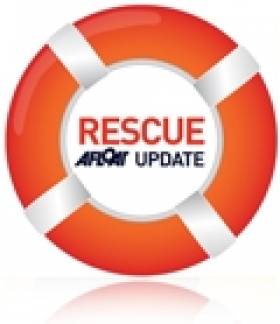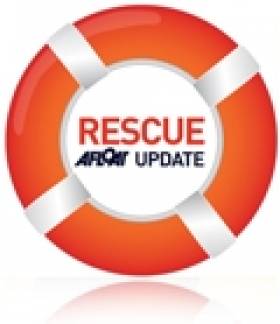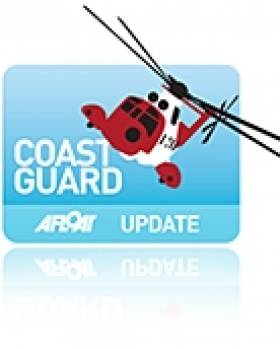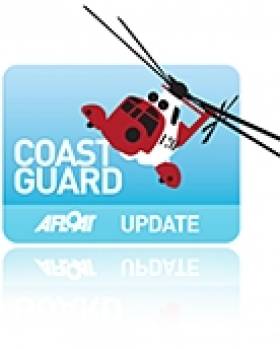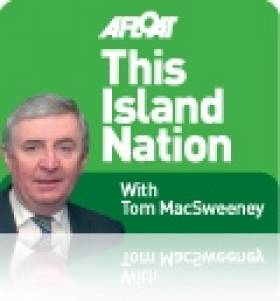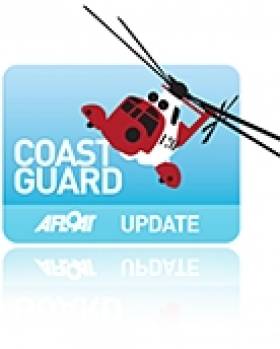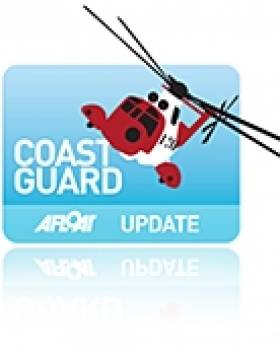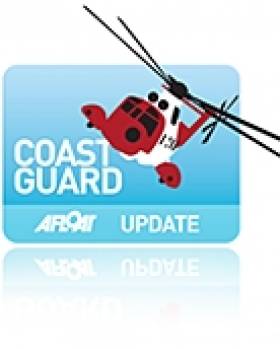Displaying items by tag: Coastguard
Teen Injured in Water at Kilkee Pier
#RESCUE - A teenage boy was airlifted to hospital yesterday after an incident at Kilkee Pier in Co Clare.
The 17-year-old, understood to be from Limerick, sustained a serious injury after diving from the pier into shallow water.
The Irish Coast Guard station at Valentia Island co-ordinated the recovery effort, with the local coastguard and paramedics sent to the pier after the alarm was raised at lunchtime yesterday.
As The Irish Times reports, the new Shannon rescue helicopter was also tasked to the scene amid concerned that the teen had injuries to his head, neck and back.
Rescuers waded into the water to recover the young man, who was treated at the scene for a serious head wound before being driven to the local golf club to the makeshift helicopter landing spot, from where he was airlifted to Galway University Hospital for treatment, according to RTÉ News.
Kilkee Marine Rescue Service chairman Manuel Di Lucia said that authorities "need to consider" the absence of a dedicated helicopter landing site in Kilkee closer to the pier.
Rescuers Guided to Donegal Swimmer By Woman With Binoculars
#RESCUE - The Irish Times reports on the rescue of a swimmer in distress off the Donegal coast thanks to the help of a woman with binoculars.
And the RNLI has paid tribute to the Malin Head coastguard unit for its knowledge of the area which was instrumental to the postive turn-out.
The man had been swimming off Five Fingers strand in Inishowen on Friday afternoon when he was washed out more than one-and-a-half miles into the sea.
The Malin Head unit of the Irish Coast Guard immediately co-ordinated the rescue effort, which saw both the Sligo coastguard helicopter and Lough Swilly RNLI lifeboat dispatched to the scene.
In an echo of June's 'miracle rescue' of a man in Cork Harbour after he was spotted by telescope, rescuers were assisted by a woman with an elevated view on the shore who spotted the swimmer and guided them to his location.
The man was quickly airlifted to Altnagelvin Hospital in Derry for treatment. He was said to be very traumatised after the incident.
“The outcome could have been different but for the local knowledge these guys have,” said Lough Swilly lifeboat spokesman Joe Joyce.
As previously reported on Afloat.ie, the coastguard radio stations at Malin Head and Valentia are both under threat of closure following a 'value for money' review of the State's marine rescue services.
Clyde Coastguard Staff Hopes Dashed After U-Turn On Reprieve
#COASTGUARD - Staff at the Clyde coastguard in Scotland have been devastated to learn that their station is still slated for closure after a U-turn on assurances from the British prime minister.
The Lennox Herald reports that David Cameron sent a letter to local campaigners Coastguard SOS which stated that all coastguard stations facing the chop would "remain open until 2015".
Rescue personnel at Clyde - who went on strike in June in protest at the treatened closure of the Western Scottish station - had been celebrating the reprieve until just days later, when the prime minister reversed his position and confirmed that planned closures would go ahead at the end of this year.
The scrapping of the Greenock control centre will see the loss of 31 jobs, with future River Clyde rescues being handled from stations around Scotland until 2015 when responsibilty will transfer across the North Channel to the Bangor control centre in Northern Ireland.
“When the prime minister writes letters like that, you don’t expect them to be wrong," said a spokesperson for Public and Commercial Services (PCS) union representing Clyde staff. “It starts playing havoc with people’s lives.”
The Lennox Herald has more on the story HERE.
Valentia and Malin Head Stations Now Both Under Threat
#COASTGUARD - Coastal communities in Kerry have joined those in Donegal protest against plans to close the Malin and Valentia coastguard stations.
In last Friday's This Island Nation, Tom MacSweeney discussed the attempts by management at the Irish Coast Guard to centralise radio operations in Dublin, commenting on the "vital component" of the stations' staff's local knowledge.
As previously reported on Afloat.ie, Minister for Transport Leo Varadkar said he would begin an action plan due in October to deal with issues outlined in a recent 'value for money' report which may require "tough decisions", including the closure of a coastguard radio station at Malin or Valentia.
Donegal TD Charlie McConalogue had already asked the Government for assurances on the future of Malin Head, which he said "has provided and invaluable service for over a century".
But the Sunday Independent has learned that now both stations are earmarked for closure, and reports that the Valentia Save Our Station group is concerned the minister is looking at an "alternative technical solution" by installing coastguard equipment from the west coast in his own constituency in Blanchardstown.
All this is despite the scheduled installation of hundreds and thousands of euro worth of new equipment in the Valentia station, which currently handles two-thirds of all major search and rescue operations annually, according to the Irish Examiner.
The change in plans has come as a surprise, the Examiner says, after similar proposals under the previous government were halted following pressure from backbench TDs.
Fisherman Airlifted from French Trawler Off West Cork
#COASTGUARD - A crewman on a French trawler off West Cork has been airlifted to hospital by coastguard helicopter, as RTÉ News reports.
The fisherman is understood to have suffered head injuries on the fishing vessel some 240km off the Beara Peninsula in the early hours of this morning Tuesday 7 August.
The Irish Coast Guard's Valentia unit co-ordinated the airlift, dispatching the Shannon rescue helicopter to the trawler. The injured man was winched on board and taken to Cork University Hospital. His current condition is not yet known.
Body Recovered from Lough Derg in Capsized Speedboat Search
#LOUGH DERG - RTÉ News reports that the body of a man in his 40s was recovered from Lough Derg on Friday night.
As previously reported on Afloat.ie, the Lough Derg RNLI lifeboat was launched to investigate an upturned speedboat in Youghal Bay near Garrykennedy on Thursday evening.
The 20ft vessel was said to have extensive damage to the outdrive and propellers, consistent with damage sustained while running.
The Killaloe unit of the Irish Coast Guard immediately launched a search and rescue operation in the area for any mossing persons, assisted by the Shannon coastguard helicopter.
There was no reports on shore of anyone overdue, and as of Friday attempts were ongoing to find out who might own the boat and who was on board at the time of the incident.
Divers with the Killaloe Search and Rescue Unit found the body some 30m from the boat and recovered it around 8pm on Friday. A post-mortem was scheduled to be carried out yesterday at Mid-Western Regional Hospital in Limerick.
Valentia Radio, Coastguard Equipment & Poor Olympic Coverage
Another attempt is being made by Coast Guard management in Dublin to close the coastal radio stations at Valentia and Malin Head and centralise operations in Dublin. That, the poor quality of television coverage of sailing at the Olympics, the future of the State's national fishing board and the launch of the national maritime plan, are amongst my topics on this week's THIS ISLAND NATION.
RESPECT FOR VALENTIA RADIO
Sailing the West Cork coastline last week Valentia Radio was a welcome companion. I listened to their regular sea area weather forecasts on VHF. They also provide the added service of message 'traffic' for vessels at sea, and advisory warnings about hazards, amongst their service. In addition to VHF Medium Frequency transmission covers a wider maritime area. The voices of the station staff become a familiar and welcome part of one's voyaging. You know they are there, a source of help and support if needed. During the week I heard them involved in search and rescue work, using their local knowledge.
On the North-Western coastline they are partnered by Malin Head Radio, providing a similar service. The staff of both have that vital component not available anywhere else, of local knowledge of their sea areas. The central base is in Dublin where staff can concentrate on the East Coast.
The service works well but high-level Coast Guard officials have been attempting for several years to centralise operations in Dublin and close Valentia and Malin. Previous attempts to do this were defeated when Coast Guard Management proposals were shown not to be in the best public interest.
I feel a sense of anger and annoyance that another attempt is being made to target the stations, emanating from the Department of Transport where a reliable source has given me details of a study on which Minister Leo Varadkar has told officials to prepare proposals which will propose what are termed 'hard decisions' before the Cabinet in October. It appears to me that Coast Guard management want one station, in Dublin, to control all output and, I am told, have repeatedly sought the adjustment of consultant reports to achieve this end. It could be done technically, but would exclude the vital aspect of local sea area knowledge which, in both Valentia and Malin has several times saved lives. It is an approach to safety which is not acceptable, with which there should be no compromise. When then Minister Noel Dempsey attempted to close the helicopter base at Waterford I raised the question – what is the value of one life? I do so again now.
NEW STATION EQUIPMENT
New equipment assigned to upgrade Valentia after the last controversy in 2009 is only due to be installed this month or next, a wait of three years!
New equipment is also being installed at present in Malin. One of the proposals by Coast Guard officials is that if a second station is needed to back-up and support the Dublin central base in case of any fault developing there and threatening a blacking-out coastal communications it should be in Blanchardstown, which just happens to be the Minister's constituency!
A new engine room, new boiler room, new security system, new generator, new operations room, an upgraded transmitter room and a helipad are due for installation in Valentia, so where is the justification for now considering closure – and at a time when other general Coast Guard stations, not radio stations, are and have been built around the country at considerable expense? Where is the logic in this?
THIRD LARGEST COASTAL STATION
Valentia is the third largest coastal marine station in Ireland and the UK. It covers the most turbulent seas in Western Europe and the roughest inland terrain in the country, where it also helps with search and rescue and deals with two-thirds of all 'Mayday' emergency calls around the coast of Ireland.
The station employs 16 people.
At present the Departmental-Coast Guard budget is putting money into a move away from the Eircom fixed line network to an independent contracted microwave network, configured to enable the coast to be covered effectively for marine radio, search and rescue, assistance information by three stations. If this was to be changed to any other configuration, if a one-centre option is chosen in Dublin, there would be an extra cost of around €10m. I have been told. Adding the €5m. already spent on the government decision to improve Valentia and Malin, I wonder what the point of all of this is? Why is Coast Guard management opposed to the costal-based marine radio stations, at the same time as building other Coast Guard bases around the coast. There seems a lack of logic in this approach.
WHAT IS THE VALUE OF A LIFE ?
In safety-at-sea terms the present maritime coastal radio station configuration of Valentia and Malin will always be required, as long-range Medium Frequency communications will stay there, used in addition to VHF to cover wider areas of reception. So even if a one-centre manned set up was followed, with an unmanned centre duplicate in case of Dublin breakdown, there would be two additional unmanned sites at Valentia and Malin to be maintained for long-range communications with attendant costs.
Dublin operates three 8-hour watches while Malin and Valentia have operated a 12-hour shift pattern with the effective saving of 2 staff positions without the requirement for overtime.
Coast Guard officials and the Minister for Transport should back away from proposals to do anything which would reduce the effectiveness of safety at sea.
They would be well advised to do so.
THE FUTURE OF BORD IASCAIGH MHARA
The Chief Executive of the national fisheries board, Bord Iascaigh Mhara, has told me that: "If you look at where the economy is at now, the need for a standalone agency dealing with seafood development makes sense more than at any time in our economic development. The case is stronger today than it has been for many a long time."
Jason Whooley was speaking to me about suggestions that BIM should be abolished and its functions absorbed elsewhere:
"I hope and would expect the review of BIM will come to the conclusion that it is vital to the seafood sector, to the fishing industry, to maintain BIM, but equally it is up to us as an organisation to constantly review ourselves and our services and deliver for the industry. People may see us as a State agency, cushioned from the wider economy and that an organisation needs a jolt. Perhaps that keeps us on our toes, because we are looking at ourselves constantly to improve our services, so I do think BIM has a strong future."
Closing BIM would, in my view, indicate disregard for the role of the marine sphere in government. The opinions of economic consultants are too easily accepted without challenging the damage they could do to the nation's future.
NATIONAL MARINE PLAN
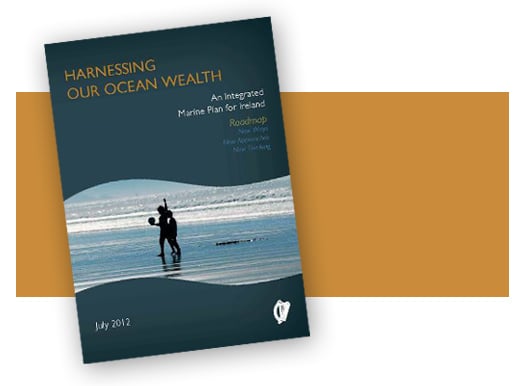
"For too long we have turned our backs on the sea. It's time now to look to our ocean as a national asset, to harness the opportunities for economic recovery. We need to treasure what we have and protect it for future generations. We also need to build on the potential of our ocean wealth and what it can give back to its people. 'Harnessing Our Ocean Wealth,' the title of this plan, puts a structure in place to make that happen".
That was the opinion expressed by Marine Minister Simon Coveney when he launched the national maritime development plan with the Taoiseach in Galway. It proposes that the value of Ireland's ocean wealth could be doubled to 2.4% of GDP and the turnover from our ocean economy be increased to more than €6.4bn by 2020.
It is a long-term outlook, but one to focus on, for seafood, fishing, marine tourism, shipping, oil and gas, renewable ocean energy and new applications for health, medicine and technology. It sets out goals to achieve a thriving maritime economy, healthy ecosystems and to increase the nation's engagement with the sea, focussing on the State creating the right conditions to promote investment and enable growth.
POOR OLYMPIC COVERAGE
I have had quite a few calls and Emails complaining about television coverage of sailing at the Olympics. It has been poor. TV coverage for the Games is provided by t Olympic Broadcast Services (OBS), an agency of the International Olympic Committee and prevents other broadcasters from covering the events. In sailing coverage has not been satisfactory and at times is done on a single camera which is not acceptable at this level of the sport. The IOC has treated sailing badly in television coverage. For a link to all the latest Irish Olympic sailing news click here.
• Email comments, opinions, information to: [email protected]
Follow more marine news and comment on Twitter: @TomMacSweeney
• And on Facebook – THIS ISLAND NATION
Shannon Helicopter Goes The Distance for Donegal Rescue
#COASTGUARD - The Shannon-based Irish Coast Guard rescue helicopter was dispatched to the Donegal coast on Friday night to rescue a young boy seriously injured in a farming accident.
As the Clare Herald reports, Rescue 115 - which only entered service a month ago - was called on to make the long-distance journey after the Sligo coastguard chopper was grounded by technical problems.
The mission put Shannon's new Sikorsky S92A craft's long-range capabilities and specialist medical equipment to the test, as it flew from Clare to Tory Island via Sligo General Hospital to evaculate the six-year-old boy, airlifting him to Letterkenny General Hospital for treatment.
As previously reported on Afloat.ie, the Irish Coast Guard took delivery of the new chopper at its Shannon base earlier this year as part of the rescue service's €500 million deal with CHC Ireland to revamp the aircraft fleet. Shannon is the only base to receive a brand new helicopter as part of the contract.
Equipped for dedicated search and rescue operations, the Sikorsky S92A provides coverage for deep Atlantic Ocean missions, services Ireland's offshore islands and provides rescue cover on the west coast from Cork to Galway.
#COASTGUARD - A Donegal TD has asked the Government for assurances on the future of the coastguard station at Malin Head, as the Donegal Democrat reports.
Fianna Fáil's Charlie McConalogue, the Deputy for Donegal North-East, said the recent 'value for money' review of the Irish Coast Guard network "raises fresh concerns for the future of what is an excellent and life-saving service in Donegal and across the North West region."
He added that Malin Head "has provided and invaluable service for over a century" with a core of "highly trained and experienced staff" who are benefitting from an "extensive upgrade" of eqiupment at the station.
"The notion that all of this work could go to waste and service could be removed entirely is a disgrace," said Deputy McConalogue, who also argued that Malin's potential closure would represent a disproportionate level of cuts to local services in the North West.
As previously reported on Afloat.ie, Minister for Transport Leo Varadkar is set to make "tough decisions" for an action plan due in October to deal with efficiencies in the coastguard network as highlighted in the Fisher Report, which may involve the closure of a coastguard radio station at either Malin or Valentia.
Woman Airlifted from Cruise Liner in Galway Bay
#COASTGUARD - Galway Bay FM reports that an elderly woman was airlifted by the coastguard from a cruise liner in Galway Bay yesterday morning.
It's believed that the passenger was experiencing cardiac problems.
The woman is a passenger on the Marco Polo, the 800-passenger cruise vessel that was recently anchored in Bantry Bay, as previously reported on Afloat.ie.
Her condition was assessed on board by paramedics before she was taken to Galway University Hospital by the Shannon-based Irish Coast Guard rescue helicopter.




























